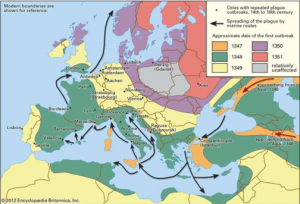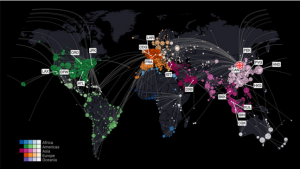Eliane Ballmer
Infectious diseases have been and still are a major cause of concern in today’s society. The spread of these diseases often causes major health as well as economic problems. Due to globalization, which has drastically increased our mobility and created pathways between most places of the world, the spread of infectious diseases is now easier than ever.
Infectious diseases (ID) have posed a threat to humankind ever since the human species has come to this world. Over and over again, new microorganisms have emerged, developed into pathogens and led to epidemics or even pandemics. In the Middle Ages, plague caused the so-called “Black Death”. It was an infection with the bacterium Yersinia pestis, which originally occurred in rodents and was transmitted to humans by the bite of fleas carrying the infection (Augustyn et al., 2019). The outburst of the disease happened in China, spread to Europe and North Africa via marine routes (see figure 1) and caused the death of about 25 million people (Augustyn et al., 2019; Zappa et al., 2009).

Figure 26.1 – Figure 1: Pathway of plague between 14th and 18th century (Augustyn et al., 2019)
After that, humanity faced many further incidents of ID such as the syphilis outbreak in Europe around 1500. Just three hundred years later tuberculosis started to spread and in 1918-19 the Spanish flu caused the infection of one third of the world’s population leading to 40 to 50 million deaths (Zappa et al., 2009). Today, ID are still a major cause of concern. In the statistics of the World Health Organization (WHO), ID still belong to the most common causes of death, especially in developing countries as shown in table 1 (BCM, 2019).
| Rank | Worldwide | Low Income Countries | High Income Countries |
| 1 | Heart disease | Lower respiratory infections | Heart disease |
| 2 | Stroke | Diarrheal diseases | Stroke |
| 3 | COPD | Heart disease | Alzheimer’s disease |
| 4 | Lower respiratory Infections | HIV/AIDS | Lung cancers |
| 5 | Alzheimer’s disease | Stroke | COPD |
| 6 | Lung cancers | Malaria | Lower respiratory infections |
| 7 | Diabetes | Tuberculosis | Colon cancers |
| 8 | Road injury | Preterm birth complications | Diabetes |
| 9 | Diarrheal diseases | Birth asphyxia and trauma | Kidney diseases |
| 10 | Tuberculosis | Road injury |
Breast cancer |
Among microorganisms, viruses are a very important source of ID. Zappa et al., 2009 claims that in the last thirty years (1979-2009) more than forty ID outbreaks have been identified in the world and that most of these ID were of zoonotic origin and caused by viruses. This is amongst other things due to their fast lifecycle, allowing them a high degree of adaption to new environmental as well as host surroundings (Zappa et al., 2009).
The current corona pandemic demonstrates once more, how vulnerable the human population is to viruses. The COVID-19 virus has spread enormously fast since its outbreak in January 2020. Figure 2 shows a forecast made in February 2020, that modelled possible routes COVID-19 might take starting from the airport in Beijing to airports around the world (BCM, 2019).

Figure 26.2 – Figure 2: Forecast of routes COVID-19 will take from Beijing airport to airports around the world, bubble size shows relative risk at each airport (BCM, 2019)
When looking at figure 2, it becomes evident that due to the numerous travelling routes, the virus can reach nearly every corner of the world. This leads to the question, whether the increase of mobility due to globalization increases our vulnerability to ID.
To explore this question, we first need to define, what globalization is, which impacts globalization has had on our mobility and how the spread of ID is influenced by that.
WHO defines globalization as follows:
“Changing the nature of human interaction across a wide range of spheres including the economic, political, social, technological and environmental. …the process of change can be described as globalising in the sense that boundaries of various kinds are becoming eroded. This erosion can be seen to be occurring along three dimensions: spatial, temporal and cognitive” (Saker et al., 2004).
This definition shows that as a consequence of globalization, countries of the world have opened up their borders. This opening partly originates from the division of labor that has occurred due to globalization, whereby production sites have spread all over the globe (ifw, n.d.). As a result, the need of transportation means has become quite urgent. In course of the huge technical development having taken place during or due to globalization, such means of transportation have been optimized, allowing us to reach nearly every spot of the world within a few hours or at maximum some days. These new means of movement not only served the transportation of goods but additionally connected people in the working world and satisfied their need of travelling to distant places. To sum up, globalization brought us an unlimited mobility connecting nearly all different places in the world with each other.
But which consequences does this increased mobility have for the spread of ID?
Clearly, the high degree of mobility is not only available to human beings but also to microbes and viruses (Zappa et al., 2009). Consequently, microorganisms that remained in their niche before globalization, have now the possibility to spread around the world where they can cause infections in these new environments (Zappa et al., 2009). The means of transportation of pathogens are either human beings themselves or transportation vehicles carrying food or other products (Saker et al., 2004). Some examples for the latter are the epidemics of tuberculosis, influenza and cholera that have been linked to the transport of commercial goods by airplanes (Saker et al., 2004) or as described in the introduction, the spread of the plague due to shipping activities. A very illustrative example for the first possibility is the human immunodeficient virus (HIV). HIV originated in Africa, where it was transferred from chimpanzees to humankind. It spread throughout the whole country by internal migration to large cities and then along commercial trading routes to the Caribbean Islands (Zappa et al., 2009). Its journey went on to America and finally reached Europe (Zappa et al., 2009). A further problematic aspect of human beings as distribution source for pathogens is, that the incubation time of most ID is about 36 hours (Saker et al., 2004). As discussed before, most places on earth are reachable in 36 hours and ID can therefore spread to nearly every place, remote or not, without being noticed by anyone. When the symptoms finally start to appear, the disease might already have spread to such an extent that drastic measures have to be taken to ensure the flawless functioning of the health system and to avoid major damage to the economy. The recent spread of COVID-19 has led to such a situation and proves our vulnerability to ID, which is enhanced by our mobility, once again.
Bibliography
Augustyn, A., Bauer, P., Duignan, B., Eldridge, A., Gregersen, E., McKenna, A., Petruzello, M., & Ray, M. (2019). Black Death | Causes, Facts, and Consequences | Britannica.com. Encyclopedia Britannica. https://www.britannica.com/event/Black-Death
BCM. (2019). Introduction to Infectious Diseases | Baylor College of Medicine |. Houston, Texas. https://www.bcm.edu/departments/molecular-virology-and-microbiology/emerging-infections-and-biodefense/introduction-to-infectious-diseases
ifw. (n.d.). Global division of labor. Retrieved March 24, 2020, from https://www.ifw-kiel.de/institute/research-centers/global-division-of-labor/
Saker, L., Lee, K., Cannito, B., Gilmore, A., & Campbell-Lendrum, D. (2004). Globalization and Infectious Diseases: A review of linkages (WHO). In Social, Economic and Behavioural (SEB) Research. https://www.who.int/tdr/publications/documents/seb_topic3.pdf
Zappa, A., Amendola, A., Romanò, L., & Zanetti, A. (2009). Emerging and re-emerging viruses in the era of globalisation. In Blood Transfusion (Vol. 7, Issue 3, pp. 167–171). SIMTI Servizi. https://doi.org/10.2450/2009.0076-08
Media Attributions
- bild 1
- bild2